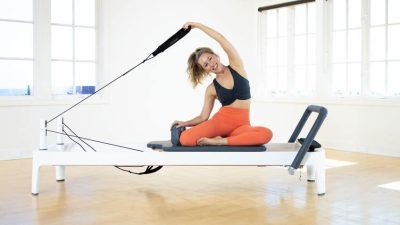
Read Full Transcript
In this tutorial, we’re going to look at the position of the shoulder blade during the roll down phase of the roll up. Now, there are several places in the Pilates repertoire where we do roll down. Some are on the Cadillac, some are on the tower units, the reformer, and the mat work. Today, I’m gonna demonstrate it to you on the mat, but understand that these bands can also represent the springs. What I want to show you first, I have two bands here, and the reason why is I want these bands to be heavy.
Now in response to the scapular position, the scapular positions are protraction and retraction for the purpose of this exercise. We know the shoulder blades go upward rotation and downward rotation and things like that. But for the purpose of this tutorial, when we start to roll back, yes, we get a curl in the pelvis, but that only happens so far. The next piece that I’d like you to explore is allowing the heaviness of these bands, or the heaviness of springs, if you will, to allow your shoulder blades to protract because the response to shoulder blade protraction is that the ribs pull backwards. So we start to get a length in a little bit higher up, and then in the lumbar curve.
So I don’t wanna keep curling and mashing my bottom, but I wanna keep allowing my shoulder blades forward, which encourages my ribs back. Then on the way up, I can start a little excursion of one blade, and then an excursion of the other blade. So I’m starting to roll up from the action of my ribs, drawing back. And having my knees and my hips flexed, I’m gonna do it again in a second. Having my knees and my hips flexed allows my pelvis to roll around my hip joint.
And having the bands be heavy enough to support the role allows me to have the feeling of a flexion force in my spine. So I’m gonna hold here for a second. I’m not locked in my legs or over squeezing my bum here, but I’m hanging onto the band. And then I’m doing excursions of my shoulder blades because when I excursion my shoulder blades, it allows the external oblique musculature on that same side to engage. And if I let both of my shoulder blades kind of go forward a smidge, then I can pull the ribs back.
I’m gonna take an inhale here. And then when I curl up, I’m gonna let the blades go. The ribs respond by pulling back. And then the action becomes a trunk curl up and not a neck hoist up or a hip hoist up. I hope you found that helpful.






